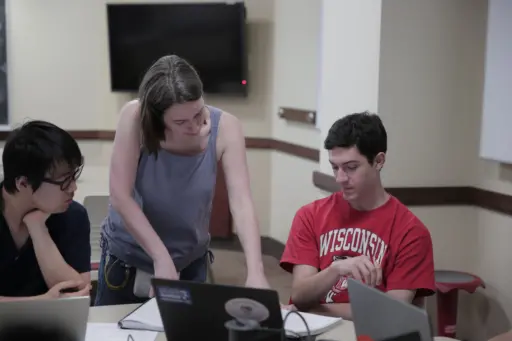Learning is most effective when students engage with the material they are taught—but getting to that point is easier said than done. Some educators have made the case that a new style of teaching called “the flipped classroom” is one way to boost student engagement: Instead of spending class time on listening to a lecturing professor, students view online video lectures on their own time at home and work on problems in class, with support from the instructor.
At the University of Wisconsin-Madison’s Department of Chemical and Biological Engineering, Associate Professor Jennifer Reed is one of several instructors who have been exploring the pros and cons of traditional and flipped classrooms for several years—in Reed’s case, since summer 2014.
“I have found that the flipped format gives students more time to digest the material and come up with questions to ask me,” Reed says. “They typically watch the video lectures for my course, CBE 255: Introduction to Chemical Process Modeling, the day before class and have time to think about what they heard before we meet.”
 In the classroom, associate professor Jennifer Reed works with students one-on-one or in small groups.
In the classroom, associate professor Jennifer Reed works with students one-on-one or in small groups.
Much of the course—designed for sophomores majoring in CBE—involves learning how to program with the software MATLAB. For this kind of material, Reed appreciates more time to work with students on computer coding problems, either one-on-one or in a small group, when she teaches the flipped version of the course in the summer.
She has also noticed that a substantially higher proportion of those summer students take advantage of office hours—perhaps because they have already come to appreciate the value of interacting with the instructor, although the generally smaller class size may play a role as well.
Reed’s colleague, Smith-Bascom Professor Regina Murphy, first explored the flipped format in summer 2013, a year before Reed did, for CBE 250: Process Synthesis. She is now combining the best of both worlds when she teaches her larger class during the school year: traditional lecturing, optional lecture watching at home, and required online quiz taking. She notes that those quizzes are “low-stakes” since the scores don’t have a big impact on the final grade.
“I think the students do well with the optional video lectures because they can review material or get additional practice when they need it,” Murphy says. “Students in a later class may even go back and review those earlier lectures if they feel a little shaky on that topic, which is a really nice use of the online format.”
The biggest advantage of that format may be that it allows students to learn at their own pace: They get to decide when they have mastered the material. In contrast, a traditional lecture exposes all students to new concepts for the exact same amount of time, regardless of their ability to process the information.
Reed notes that the flipped classroom also makes it easier for students to provide feedback to instructors. “Observing how the students tackle the hands-on problems during class, in what we call discussion sections, helps me figure out what’s confusing to them so that I can clarify concepts more quickly,” Reed says. “If I don’t get that feedback, it’s much harder to make course adjustments.”
Another benefit of the discussion sections—especially for learning a programming language—is that students can compare their own problem solutions with others. Reed says this is extremely effective in illustrating how different versions of computer code all arrive at the same final answer, but with different efficiencies: Some programs are much shorter than others.
For Reed and Murphy, the flipped classroom is here to stay. “I think it’s more interesting for students to be actively working on problems during class time, with the teacher serving as a coach, compared to passively listening to a lecture,” Reed says. “And I would agree that this teaching style puts students in the driver’s seat for their learning experience and increases their overall engagement.”